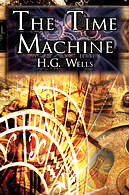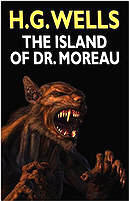|
 |
Herbert
George Wells was the son
of a shopkeeper and first worked as a draper's asistant. He later
qualified as a teacher, studied hard at night school and took a degree in
science. He settled in London and in 1891 he
married his cousin Isabel and continued his career as a teacher in a
correspondence college. In 1895 Wells left Isabel for one of his
brightest students, Amy Catherine, whom he married in 1895. Wells lived
through World War II in his house on Regent's Park, refusing to let the
blitz drive him out of London. In 1945, his last book expressed real
pessimism about mankind's future prospects. Wells died in London on
August 13. 1946.
|
|
|
Click
on the cover to download your book / Haz clic en la tapa
del libro para
descargarlo. |
|
 |
THE
TIME MACHINE
Science-fiction
As
a novelist Wells made his debut with this famous classic science novel
which presents a parody of English class division. The narrator is Hillyer, who discusses with his friends about theories of time travel. A
week later their host the Time Traveler has an incredible story to tell.
He had found two people: the Eloi, weak and little, who live above
ground in a seemingly Edenic paradise, and the Morlocks, bestial
creatures that live below ground, who eat the Eloi. The Traveler's
beautiful friend Weena is killed, he flees into the far future, where he
encounters "crab-like creatures" and things "like a huge
white butterfly", that have taken over the planet. In the year
30,000,000 he finds lichens, blood-red sea and a creature with
tentacles. He returns horrified back to the present. Much of the
realistic atmosphere of the story was achieved by carefully studied
technical details. The basic principles of the machine contained
materials regarding time as the fourth dimension - years later Albert
Einstein published his theory of the four dimensional continuum of
space-time. |
|
|
|
 |
THE
WAR OF THE WORLDS
Science-fiction
This
famous novel is about an invasion of Martians. The story appeared at a
time when the discovery of Martian "canals" arose speculations
that there could be life on the Red Planet. The narrator in this book is
an unnamed "philosophical writer" who tells about events that
happened six years earlier. Martian cylinders land on earth outside
London and the invaders, who have a "roundish bulk with
tentacles" start to vaporize humans. The Martians build walking
tripods which ruin towns. Panic spreads, London is evacuated. Martians
release poisonous black smoke. Orson Welles' Mercury Theater radio
broadcast, based on The War of the Worlds, caused a panic in the
Eastern United States on October 30, 1938. In Newark, New Jersey, all
the occupants of a block of flats left their homes with wet towels round
their heads and in Harlem a congregation fell to its knees. Welles, who
first considered the show silly, was shaken by the panic he had
unleashed and promised that he would never do anything like it again. |
|
|
|
 |
THE
ISLAND OF DOCTOR MOREAU
Science-fiction
The text of the novel is the
narration of Edward Prendick, a shipwrecked man rescued by a passing
boat who is left on the island home of Doctor Moreau, a mad scientist
who creates human-like hybrid beings from animals via vivisection. The
novel deals with a number of philosophical themes, including pain and
cruelty, moral responsibility, human identity, and human interference
with nature. "The Island of Doctor Moreau" is a classic of early science
fiction and remains one of Wells's best-known books. |
|
|
|
|
All
contents is for educational and informational use only. All books remain the right of the original copyright holder, and no infringment is
here intended / Todo
el contenido es pura y exclusivamente para uso educativo e informativo. Todos
los libros continúan permaneciendo al poseedor original de los derechos autorales, no existiendo aquí intención alguna de infringir la ley. |
|